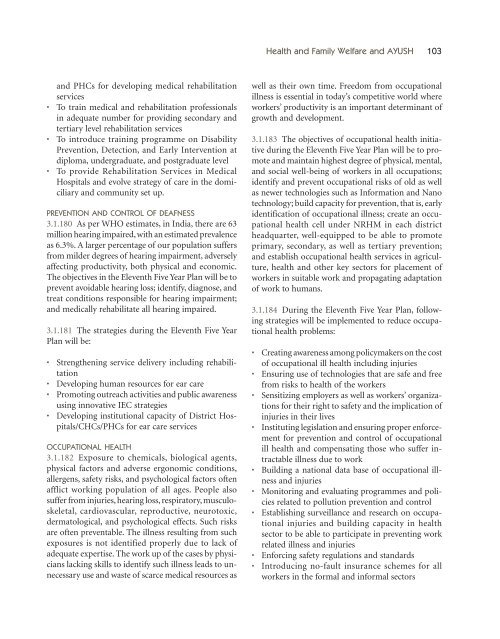Eleventh Five Year Plan
Eleventh Five Year Plan
Eleventh Five Year Plan
Create successful ePaper yourself
Turn your PDF publications into a flip-book with our unique Google optimized e-Paper software.
Health and Family Welfare and AYUSH 103and PHCs for developing medical rehabilitationservices• To train medical and rehabilitation professionalsin adequate number for providing secondary andtertiary level rehabilitation services• To introduce training programme on DisabilityPrevention, Detection, and Early Intervention atdiploma, undergraduate, and postgraduate level• To provide Rehabilitation Services in MedicalHospitals and evolve strategy of care in the domiciliaryand community set up.PREVENTION AND CONTROL OF DEAFNESS3.1.180 As per WHO estimates, in India, there are 63million hearing impaired, with an estimated prevalenceas 6.3%. A larger percentage of our population suffersfrom milder degrees of hearing impairment, adverselyaffecting productivity, both physical and economic.The objectives in the <strong>Eleventh</strong> <strong>Five</strong> <strong>Year</strong> <strong>Plan</strong> will be toprevent avoidable hearing loss; identify, diagnose, andtreat conditions responsible for hearing impairment;and medically rehabilitate all hearing impaired.3.1.181 The strategies during the <strong>Eleventh</strong> <strong>Five</strong> <strong>Year</strong><strong>Plan</strong> will be:• Strengthening service delivery including rehabilitation• Developing human resources for ear care• Promoting outreach activities and public awarenessusing innovative IEC strategies• Developing institutional capacity of District Hospitals/CHCs/PHCsfor ear care servicesOCCUPATIONAL HEALTH3.1.182 Exposure to chemicals, biological agents,physical factors and adverse ergonomic conditions,allergens, safety risks, and psychological factors oftenafflict working population of all ages. People alsosuffer from injuries, hearing loss, respiratory, musculoskeletal,cardiovascular, reproductive, neurotoxic,dermatological, and psychological effects. Such risksare often preventable. The illness resulting from suchexposures is not identified properly due to lack ofadequate expertise. The work up of the cases by physicianslacking skills to identify such illness leads to unnecessaryuse and waste of scarce medical resources aswell as their own time. Freedom from occupationalillness is essential in today’s competitive world whereworkers’ productivity is an important determinant ofgrowth and development.3.1.183 The objectives of occupational health initiativeduring the <strong>Eleventh</strong> <strong>Five</strong> <strong>Year</strong> <strong>Plan</strong> will be to promoteand maintain highest degree of physical, mental,and social well-being of workers in all occupations;identify and prevent occupational risks of old as wellas newer technologies such as Information and Nanotechnology; build capacity for prevention, that is, earlyidentification of occupational illness; create an occupationalhealth cell under NRHM in each districtheadquarter, well-equipped to be able to promoteprimary, secondary, as well as tertiary prevention;and establish occupational health services in agriculture,health and other key sectors for placement ofworkers in suitable work and propagating adaptationof work to humans.3.1.184 During the <strong>Eleventh</strong> <strong>Five</strong> <strong>Year</strong> <strong>Plan</strong>, followingstrategies will be implemented to reduce occupationalhealth problems:• Creating awareness among policymakers on the costof occupational ill health including injuries• Ensuring use of technologies that are safe and freefrom risks to health of the workers• Sensitizing employers as well as workers’ organizationsfor their right to safety and the implication ofinjuries in their lives• Instituting legislation and ensuring proper enforcementfor prevention and control of occupationalill health and compensating those who suffer intractableillness due to work• Building a national data base of occupational illnessand injuries• Monitoring and evaluating programmes and policiesrelated to pollution prevention and control• Establishing surveillance and research on occupationalinjuries and building capacity in healthsector to be able to participate in preventing workrelated illness and injuries• Enforcing safety regulations and standards• Introducing no-fault insurance schemes for allworkers in the formal and informal sectors












![[Tam] Uygula[ya] - Bilim, Teknoloji ve Ä°novasyon Politikaları TartıÅma ...](https://img.yumpu.com/36820041/1/184x260/tam-uygulaya-bilim-teknoloji-ve-anovasyon-politikalara-tartaama-.jpg?quality=85)



